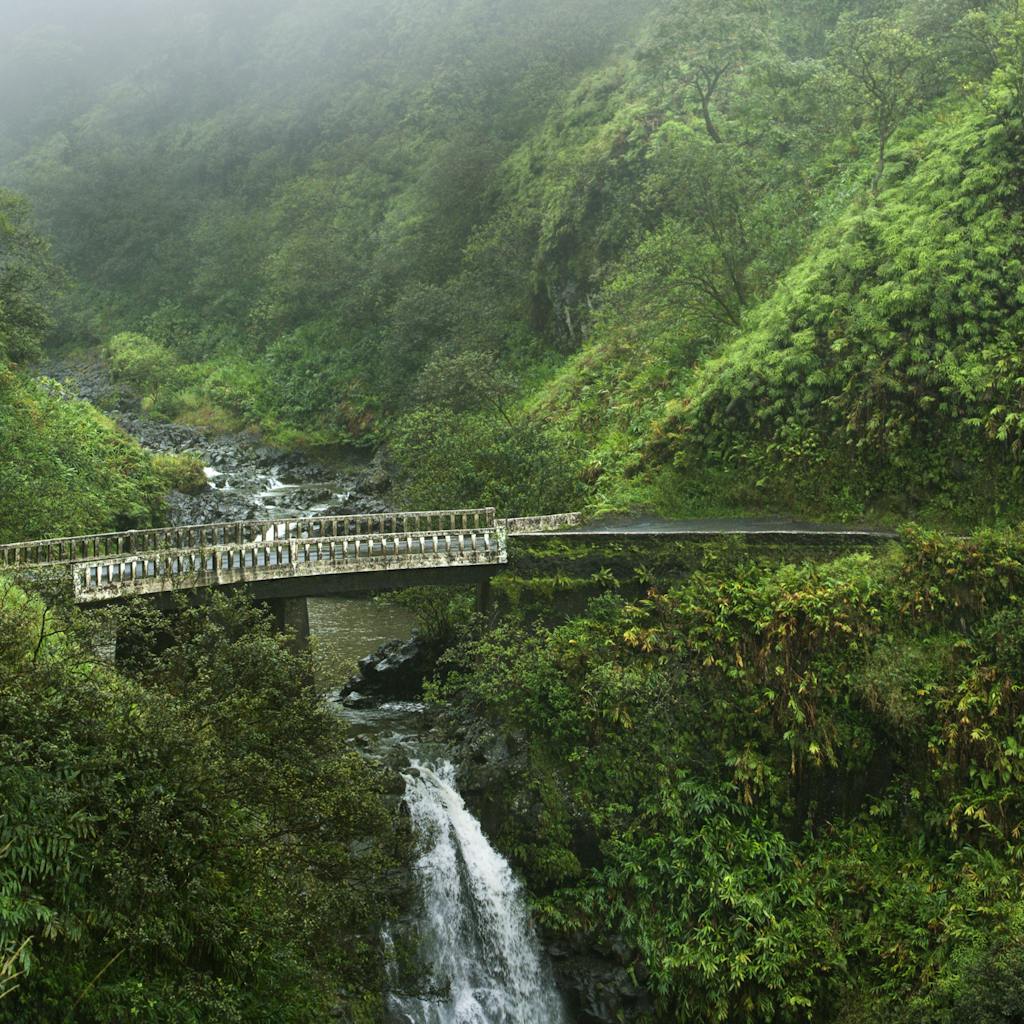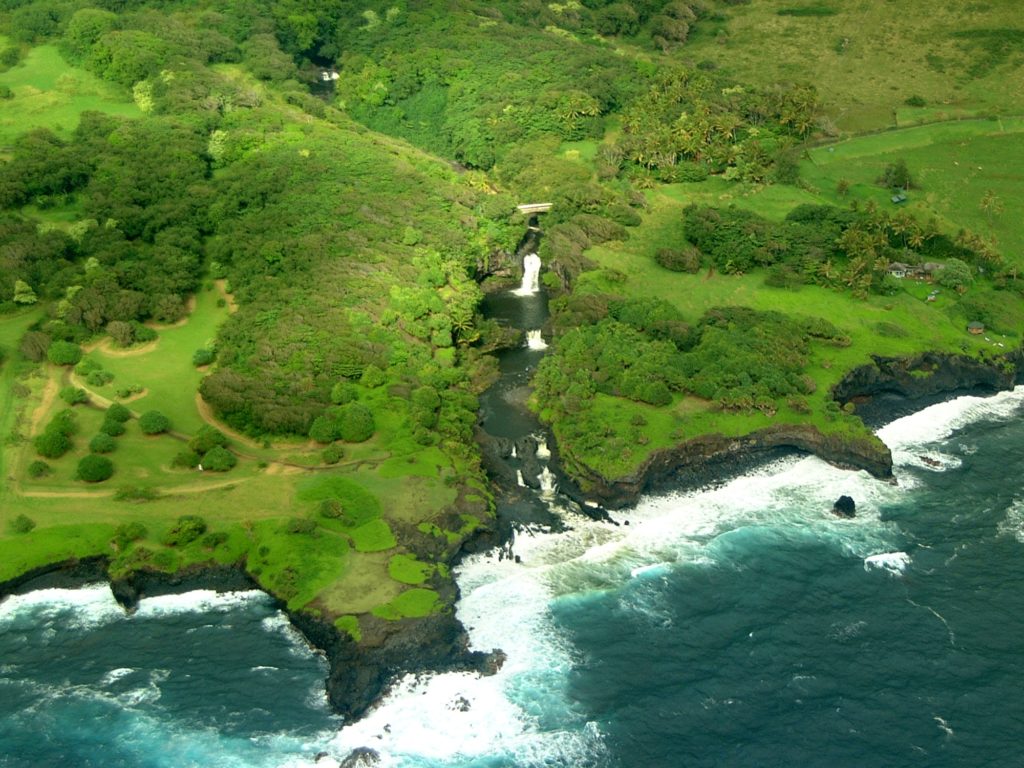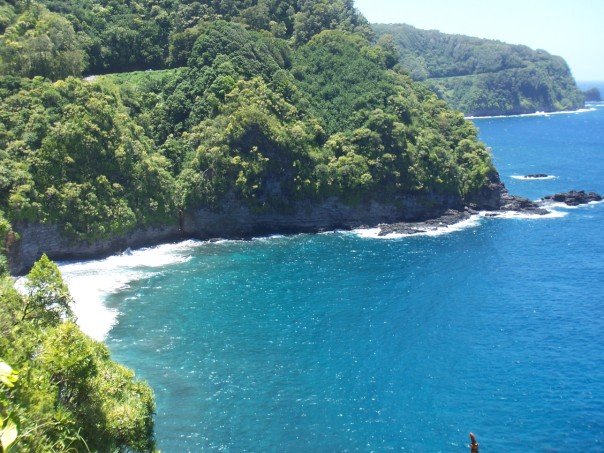The road to Hana was a must-do activity for us while on Maui, hands down. And after all the hype, I was downright ecstatic for this adventure. Images of waterfalls, dripping rainforests, beach vistas, and fresh streams played in my head, and my expectations were set quite high after everything I’d heard. A quick search on Google and an address was inserted into the iPhone map and we were on our way from Kaanapali (Maui’s west side). We weren’t discouraged by the two-hour drive, the windiness of the road, or our beater rental car (although this would be enough to turn many folks away!) because this adventure was listed as a top priority for our vacation. Completely unfamiliar with Maui and the routes around the island, we relied 100% on our iPhone map app and began the journey by heading toward Kahului. We then snaked down through Kula, past the Maui Winery and Tedeschi Winery, and down through Paia. We were accessing the Road to Hana via the west side, and no one in our group was experienced.
Transition into Tropical Wonderland: The Road to Hana

If you’ve ever taken this route to Hana, then you may know what’s ahead. After a solid hour of driving on a road where the hills were so steep you couldn’t see the car coming at you, and through terrain that was likened to a dry desert, we still hadn’t seen one waterfall, and certainly no lush greenery that we’d been hearing about from people on Hawaii Vacations on Maui. I was so dizzy and disappointed from the car ride that we ended up pulling over on a cliff to get some fresh air. Our group couldn’t figure out what had gone wrong. “This is NOT the road to Hana I envisioned!” I was completely exasperated. I had been hearing, writing, and envisioning about this place for so long and now I was finally here, but it was NOTHING like what I anticipated. It was dry, unsightly, and a total letdown. I wanted to turn back.
But we kept coursing along, everyone adamant about getting to the Seven Sacred Pools. As time wore on, the scenery began to transform. We rounded a sharp valley and it was like the island had changed. Dry hillsides and scraggly trees were exchanged for green gullies and verdant banyan trees. Moisture became apparent in the air and the roadside was teeming with palms, ferns, vines, and tropical wildflowers. I let out a sigh and gone was my disappointment. We had made it past the rain shadows of the steep valleys. Maui, like many of the other Hawaiian Islands, has dry sides and wet sides to its land. The dry sides remain relatively waterless because the steep mountains and valleys prevent the rain from falling, thus giving the dry side a desert-like appearance. Of course, I knew this about Maui, but I thought the road to Hana was completely green, from beginning to end, and I never thought that by traveling a different route you would gain a different, dry perspective of this popular drive. (And reflecting back now, the desert drive was absolutely beautiful in its own way. I was just too disappointed to see past this aspect. But make sure to take in this beauty, because it’s just as unique as the rainforests, and deserves just as much hype as the rest of the road to Hana).

Once in the greener parts of Hana, little shops and restaurants began popping up. The first roadside stand we saw was a burger joint, literally the size of what your outstretched arms can touch, with a paniolo (Hawaiian cowboy) leaning out the window. He beckoned us in as we drove past him, but given the cows grazing on the hillside, we decided against it. Another shop selling beer, wine, and sake popped up, which was busy with travelers. People sat outdoors on the lanai and drank cold brews, while kids ran around the property and chased chickens. There were also multiple flower stands, fresh fruit and vegetable stops, a convenience store, and other little highway stands that were quaint and unique. We didn’t stop at any of these, however, because we were on a mission to find the Seven Sacred Pools.

The Seven Sacred Pools: Nature’s Hidden Havens
Our iPhone map finally labeled Haleakala National Park in our vicinity, and we knew we were close. We ended up driving right past the entrance to the park and continuing on over a cement bridge, from where you could see a few of the sacred pools. These were crowded with people, but even with the swarm, the beauty was astounding. These freshwater pools were huge, and small waterfalls cascaded into the lower pools. The water eventually finds its way into the ocean, which these pools butt up against, and it makes for an incredible view of the ocean, pools, and valleys, all in one glance. Because of the crowds here, we decided to park in the paid lot ($10), hike the Pipiwai Trail to the 400-foot Waimoku Falls, and find our own sacred pool to swim in. Again, we didn’t quite know what to expect of this hike, but it was fantastic. Barely strenuous and easy enough for anyone, the hike is roughly 40 minutes one-way. You walk along a beaten path through strawberry guava trees, dense rainforest, and bamboo, but none of what I’m about to tell you will do this beauty justice.
There are multiple lookout points along this hike, all of which are marked by caution signs. The lookout points are directly on sheer cliffs, so you need to make sure you do not get too close or let kids run around these areas. But like any outdoor sport, use caution and good judgment and you shouldn’t run into too many problems or danger. I would consider this hike pretty safe too, considering some of the other ones I’ve done in Hawaii. There were plenty of kids on the trail and 60+ folks too, so I would recommend this hike to almost anyone. The lookout points boast dramatic views of Maui’s valley, quickly reminding you as to why it’s called “The Valley Isle”. Multiple waterfalls and natural swimming pools adorn the land as well, and if you let sightseeing take over hiking, the trail will easily end up taking you over an hour to complete one way.
My favorite part of the hike was not the magnificent waterfall at the end, or the thrilling river crossings. It wasn’t the secluded pool we found to swim in, and it wasn’t the fresh-picked strawberry guavas off the trees. It wasn’t the dark bamboo forests or the elevated boardwalk through the mud. It wasn’t even the giant banyan tree or the footbridges across the raging waters. Now that I’ve mentioned all these incredible features of this hike, you’re probably wondering how it could get any better. But for me, it did. For me, the best part of this hike was the wild white ginger that grew alongside the trail, permeating the air with the freshest, most beautiful scent in the world. You smell it and immediately think someone is wearing perfume, but then you begin to see the drooping spots of white against the green forest and realize the white ginger is everywhere.
I was so intoxicated by the scent that I picked a flower and tucked it behind my ear. Many people along the trail stopped to ask what flower it was, and when I told them it was the white ginger that scents the rainforest, everyone was in awe. To complete the description of this hike, my second favorite part was the sounds of the bamboo clinking hollowly against the other stalks. These forests are so dense that no sunlight can shine through, and the only thing growing in the path of the bamboo is more bamboo. When the wind blows, the stalks gently sway, making that light, hollow sound that is replicated with popular bamboo wind chimes. The fact that these two things came together on one hike was incredible to me, and it made the adventure truly magical.
The Seven Sacred Pools are strung along the hike like pearls, and many of them are safe to access. We pulled off the trail and found our own little hideaway, where we jumped in and swam to cool off and then warmed back up again on the lava rocks. Once back in our car, we enjoyed a picnic lunch and recapped the incredible moments of the hike. And since we had driven the road to Hana in the opposite direction, we had the entire drive left to look forward to.
Reflections: Recapping an Unforgettable Adventure
This drive was insane. We stopped counting the waterfalls once we got to fifteen because there were just so many of them. Like the road before, this one too had many stops along the way, including restaurants, gift shops, flower stands, and huts where you could find unique gifts and handmade crafts. We passed by the secluded Travaasa Hana, the infamous Jaws surf break, and so many lookout points it was enough to make any nature enthusiast go mad. The lush side of Maui is unlike anything I’ve seen in Hawaii. The deep valleys are one-of-a-kind and the drive carves along the side of the cliff (literally), so that all you see is tropical rainforest. We did this entire adventure in roughly 8 hours, and it ended at night, which meant we beat the early morning crowd. The road was desolate and the crowds were scarce, and I can’t think of any better way to have celebrated my fiancé’s 29th birthday.
We’re here to help, check out our All-Inclusive Hawaii Packages or get help with airfare, picking hotels or activities. If it’s in Hawaii we can make it happen.
Get Help With Planning
